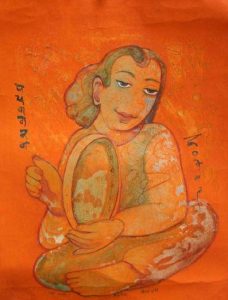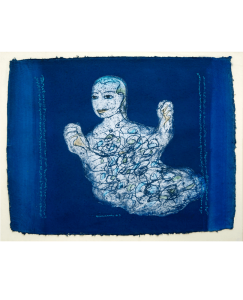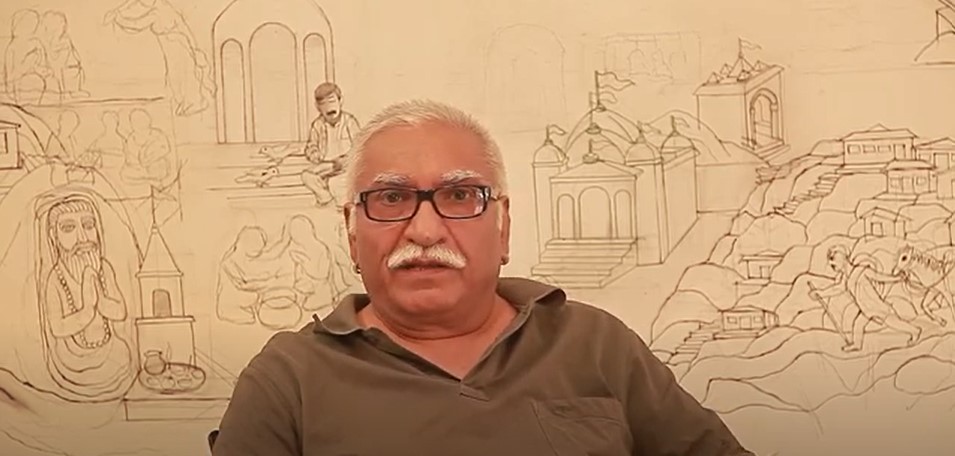Prachi Sahasrabudhe
Sidharth was an ordinary guy who wished to move to a place where he could live the life of an artist. He had little money and was left with a large collection of paintings and verses that he had produced and sang during his lonely nights at the farmhouse. Someone recommended Delhi, which Sidharth thought was a fantastic idea. It was not his friends or the location that drew him to the name Delhi, but it was the closest place to Chandigarh, and the money he had would have only allowed him to travel to Delhi.
While wandering the streets of Delhi, Sidharth was a hungry man with a creative fire in his imagination and a genuine want for food in his stomach. He would have approached any man on the street and asked for money for food, but he needed a compelling reason to extend his hands to someone or something. He met several folks and realised that everyone was a traveller in some way and an orphan in a sense. People desired to connect with others, but they were afraid of its power and tried to avoid it. Sidharth pondered if he wanted to become one of the lost people or grasp life by the neck, stare into its eyes, and ask for a place for himself. However, this seemed like a violent thought.
Sidharth landed in Delhi where he met a businessman from Ghaziabad. He accepted an invitation to a man’s home in Ghaziabad and was adopted by the family. Sidharth was given an apartment and asked to sit and paint in exchange for nothing much but his affection. The family became a part of Sidharth’s life and he felt safe and at home. He had found a place to live and work, as well as a family and people who cared about him. He had to get go of his newfound luxuries and rebirth as an artist. The bird had finally discovered its nest.
One day, Sidharth observed a few girls hopping on the ground and remembered his childhood. He created a ‘Hopscotch’ series akin to the Mela series, which began in a figurative manner and progressed towards abstraction. He wanted to portray the movement and momentum of the youngsters playing the game while also getting the grid correct. This series marked the beginning of his artistic career, as he wanted to portray the movement and momentum of the youngsters playing the game while also getting the grid correct. He was preoccupied with the grid and the progression of life. He seldom visited Delhi and was slow to establish new acquaintances. The Hopscotch series was only the start of his soon-to-be
thriving creative career as an artist. Even now, he will work on a series until he is satisfied with it, at which point he will quit. He continues to do some things because the act of doing it is a trip for him, and when he believes he has arrived, he quits working on it. Sidharth’s paintings grew repetitious and abstract, and he discovered he did not have to be a prisoner of his own style. He believes that art is all about progression and progress and that it has its own organic growth. He also believes that an artist’s style is influenced by the artist’s personality and way of thinking and that it evolves.
While sitting in his Ghaziabad flat, haunted by memories of his mother, Sidharth developed the ‘Ball of Rags’ series. He wondered what his mother had hidden between the covers of the rag balls he used to play with. He understood the philosophical implications of rag balls, as well as his act of peeling them off to see what was within. He painted the rag ball with children clutching and playing with it before moving on to abstraction. He immediately recognised the necessity to create something out of the frames and began gathering rags from all throughout town. He painstakingly created the rag balls and utilised them to construct an installation, which he showed at the Sridharani Gallery in New Delhi in 1994.
 Artist Siddharth Studio, https://www.youtube.com/
Artist Siddharth Studio, https://www.youtube.com/
During the mid-1990s, Sidharth’s shows organised by various galleries in Delhi were a huge success. He kept his social relations to a small circle of pals and his monthly meetings at his house were popular among his artist-writer-singer friends, and one of Delhi’s gallerists financed these ads. At a time when everyone was looking for their five minutes of fame, Sidharth was getting away from it all. The weekly meetings at his house were energising, and one of Delhi’s gallerists encouraged these ads. There was free alcohol, a variety of food brought in by many individuals, a lot of tales, and a sense of community. Sidharth was having a good time with his pals. But it gradually melted away. The passage of time necessitates a shift in lifestyle.
Sidharth was more drawn to work on the paper after the Ball of Rags series. Sidharth discovered wasli paper in Sanganer, Rajasthan, and travelled to Jaipur to meet a family of Central Asian wasli paper producers. A family of Central Asian wasli paper producers was brought to Sanagner to make paper for the Rajasthani miniature artists of the time. However, as India entered the twentieth century, patronage began to dwindle. He struck a better bargain with them, instructing them to manufacture as many sheets as they could and providing eighty times more money per sheet than they had quoted. The family now produces roughly 30,000 sheets each year, and all the papers are consumed by artists.
Soon, Sidharth was unsatisfied and desired to abandon everything and become nothing. With the advice of his friends, he decided to travel and packed the greatest cameras and video cameras he could find and embarked on a month-long expedition to India, visiting villages, shrines, temples, heritage sites, churches, mosques, abandoned caverns, historical sites, etc. He chronicled outstanding works of art done by obscure artists and craftspeople without being aware of it. After his trip, Sidharth became a reclusive and aloof man and edited the film he took throughout his trips into many movies about Indian art. His subsequent works demonstrate his proclivity to delve further into the issues he addresses. ‘Neti Neti’ was a series of paintings created by Sidharth following his travels. Sidharth created a collection of paintings that convey India’s intellectual foundation. ‘Neti Neti’translates as “Not this, not that,” and it hints at Sidharth’s shifting palette, style, and figuration. The pieces in the ‘Neti Neti’series represent a fledgling ethereal person who has realised that being defined by gender, politics, nationality, or anything else is pointless. In addition to the ‘Neti Neti’ series, Sidharth has produced three more series, Pancha Tattva, Lotus, and Messengers. Sidharth accepts both good and negative feedback with equal calm.
 Musician, Sidharth, https://m.mojarto.com/
Musician, Sidharth, https://m.mojarto.com/
Sidharth is an artist who uses art, poetry, and melodies to communicate his ideas. He believes that even the most ordinary people may aspire to a better future in which equal rights and justice prevail, people respect one another, and everyone believes they are a dreamer. He examines the term ‘Bhagavan’, which is a compound of Bhoomi (earth), Gagan (sky), Vayu (air), Agni (Fire), and Neer (Water). He depicts these aspects and their many plays throughout life in Pancha Tattva, using allusions from previous works to better comprehend his own life. Nature’s visions can be observed when delving into its deeper mysteries.
 “Rahiman dhaga prem ka mat, toro,” chatkaye II, Sidharth,
“Rahiman dhaga prem ka mat, toro,” chatkaye II, Sidharth,
Natural pigment on handmade paper,26.5″ x 34.5″, https://www.gallerienvya.com/
Sidharth’s Lotus and Messengers series seeks to depict higher spirits manifested in human forms without regard for gender. His travels in India play an important part, with references to Gandharvas, kinnaras, apsaras, and angels adorning the walls of temples and churches. Sidharth had grown increasingly reclusive and studious by the turn of the millennium, and the inevitable completion of his nature series was visible in Barah Masa (Twelve Seasons). Sidharth discovered wonderful depictions of months in Indian traditional, folk, and classical literature. Guru Nanak has written extensively about each month, and for him, it is a man’s journey to holiness. Sidharth spent four years gathering Barah Masa texts and visual depictions from throughout the world to complete a series on shifting seasons or calendar months. He studied literature and journeyed to many parts of India to collect flowers, stones, and insects for his paints. In Sidharth’s paintings, a full moon-like figure hovers in the forefront or background, Sachidanandan’s phrase “The love of madmen is like rivers. During full moon nights it overflows” resonates true.
***
References:
- ML, Johnny, “The circle of Light – Life and times of Siddharth,” Chennai, Prakrit Arts Pvt.ltd., p.p. 48 to 60.
- ML, Johnny, ‘By all means necessary,’ July 2011, JohnyML. blogspot.com. • https://www.gallerienvya.com/artist/sidharth/





